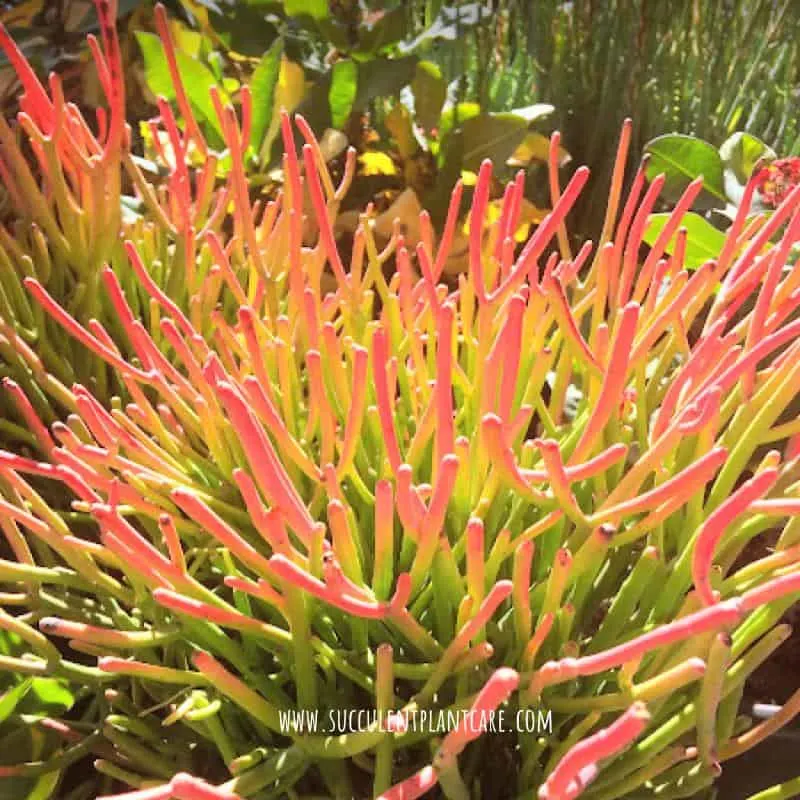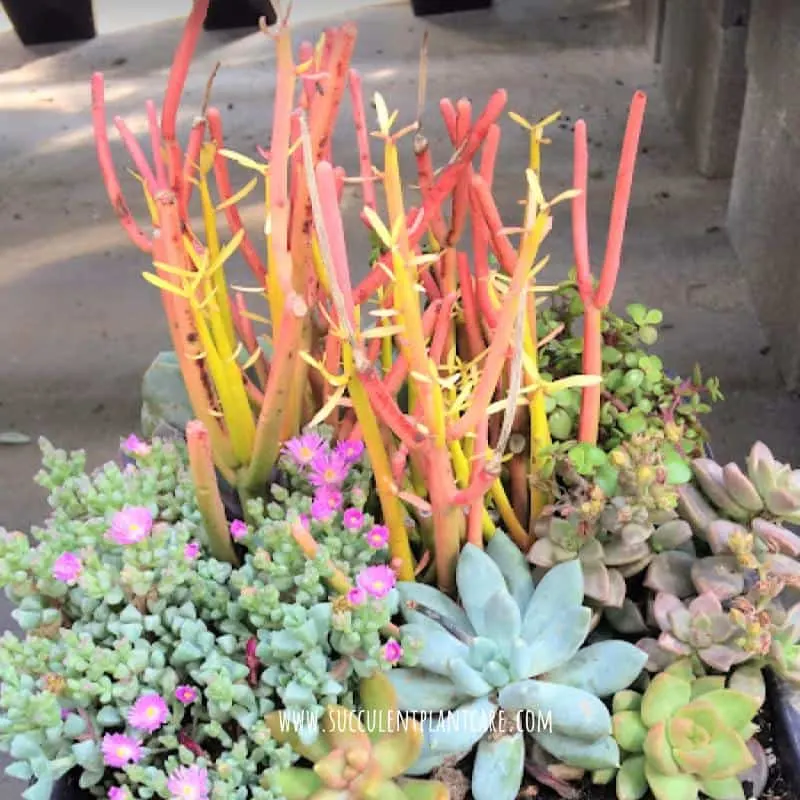Euphorbia Tirucalli is native to Africa but is widely distributed in different parts of the world. It is known by common names such as Sticks on Fire or Firesticks, Pencil cactus, and Pencil tree. Euphorbia Tirucalli has pencil-thin stems that turn a fire-red color during the colder months.
The stems’ color can range from red, orange, yellow and green depending on the season and temperature. The plant can grow tall and tree-like, up to around 8-10 ft. (2.4-3 m.) tall. The sap of the plant is toxic and can cause severe irritations so care is needed when handling this plant. Learn more about care, propagation, toxicity and growing tips right here.

Is the Euphorbia Tirucalli grown indoors or outdoors?
It can be grown both indoors and out. However, the plant does very well with plenty of sunlight so whether you grow it indoors or out, be sure to provide plenty of sun for it to thrive.
Indoor Lighting Requirements
Euphorbia Tirucalli needs plenty of sunlight to survive and thrive. When growing the plant indoors, choose the brightest area in the house to place your plant. Generally speaking, a plant like this that requires a lot of light will do well in a south facing window where it can get the most sun. East and west facing windows will also work.
Try to provide at least 5-6 hours of sunlight per day indoors so the plant receives enough light. For areas with inadequate indoor lighting or poor lighting conditions, consider using a grow light. Grow Lights are good investments to have especially if you have long, dark winters or if your area does not receive enough sunlight. Here are some of my grow light recommendations.
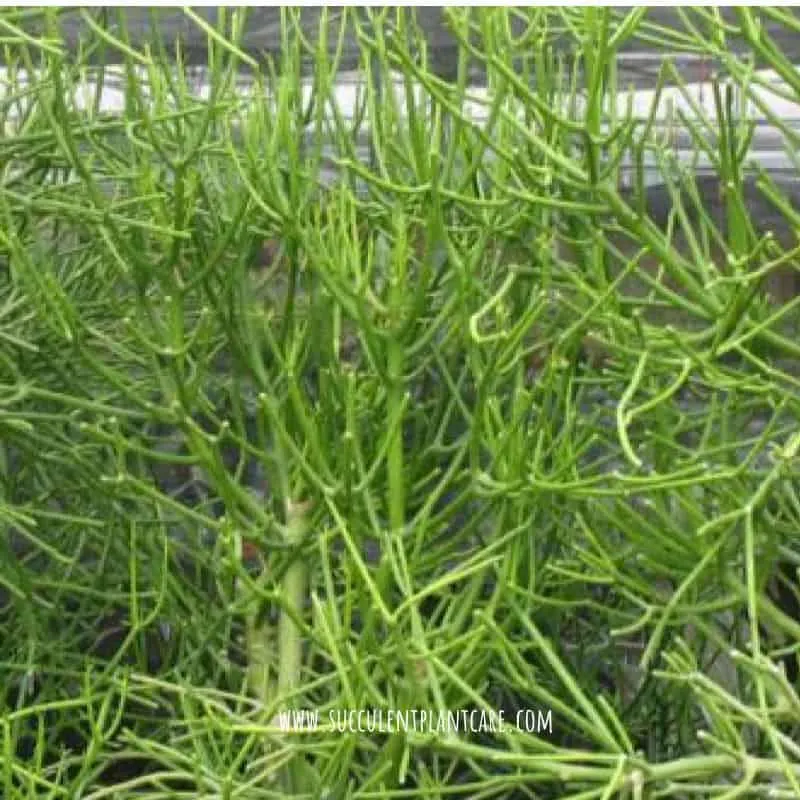
Euphorbia Tirucalli with green stems
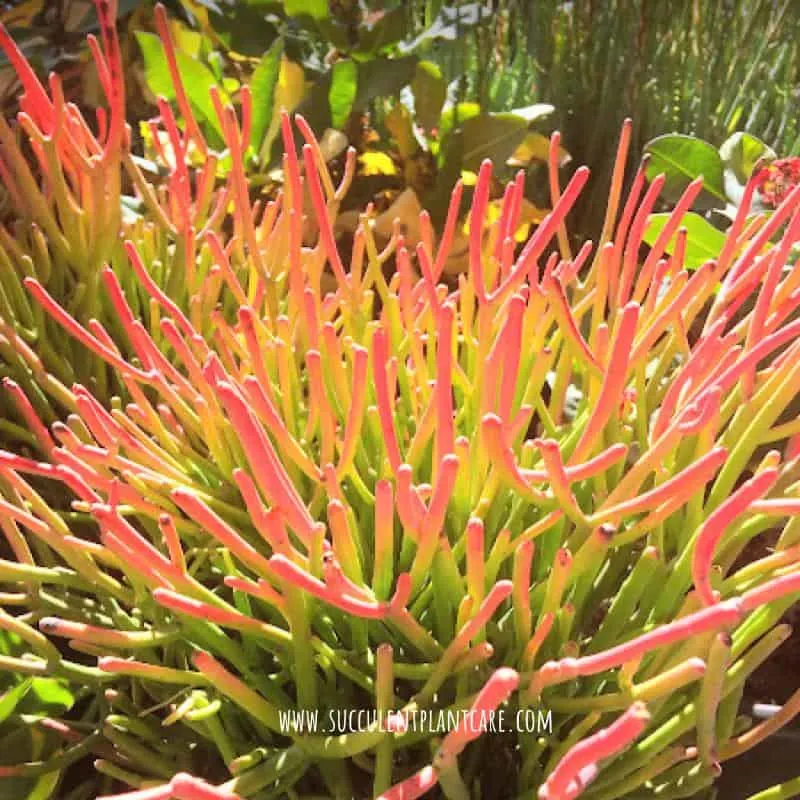
Euphorbia Tirucalli with fire-red stems
Outdoor Sunlight Requirements
Euphorbia Tirucalli grows best in full sun. Partial shade may be tolerated as long as the plant meets its sunlight requirement most of the time. This plant will not do very well in the shade for prolonged periods of time. The more sun it receives, the more vibrant its colors become. In the shade the color stays mostly green.
Before moving the plant outdoors or increasing the amount of sunlight it receives, it is better to acclimate the plant to prevent sunburn. This will help prevent sunburn or sun damage. Can be grown in-ground in full sun in temperate climates.
Frost Tolerance
USDA Hardiness Zone: Zones 10-11 (hardy until around 30 °F or -1.1 °C)
Euphorbia Tirucalli is not a very frost hardy plant. It can tolerate mild frost for a very short period of time. It does well in temperatures over 30 °F or -1.1 °C. It can tolerate temperatures below that but not for long periods of time.
If you live in USDA hardiness zones 10-11, you can leave the plant outdoors all year long and they can even be planted in-ground. If you have extreme winter conditions in your area, the best way to grow these plants is in containers. That way you can bring them indoors during winter or when there is forecast of frost or snow.
There are ways to protect the plant from frost or freezing temperatures outdoors if you can’t bring it in for the winter. Frost cloths and mini greenhouses can help them survive the cold winter. Here are some of my recommendations for frost protection.
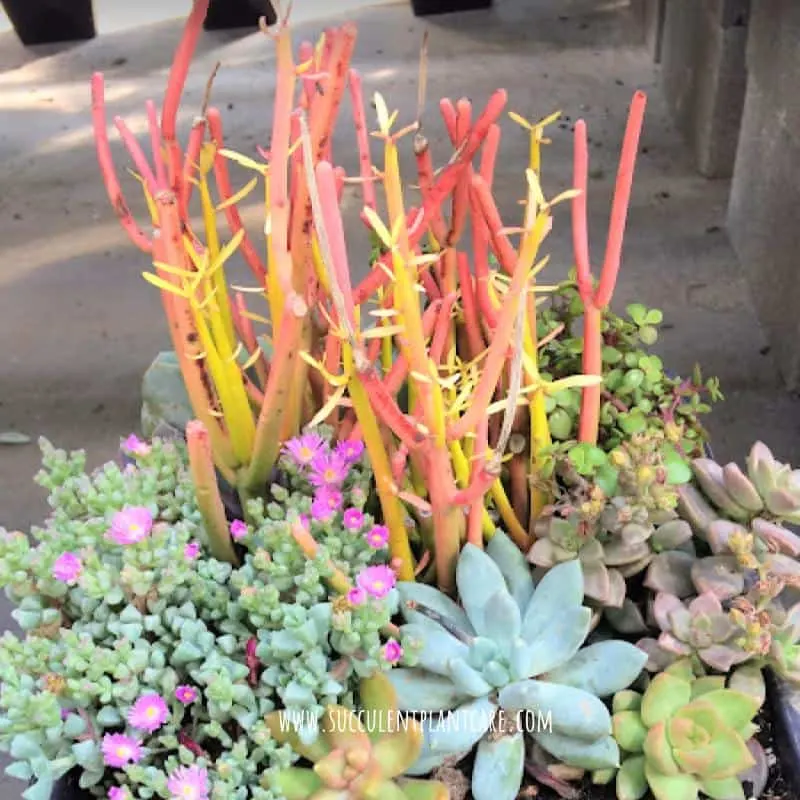
Soil Requirements
Just like with other succulent plants, Euphorbia Tirucalli needs a well draining soil. Here’s a simple, tried and tested concoction that has worked well for my plants. I like to use cactus potting mix combined with perlite for more drainage. I do not use exact measurements but eyeball it to about 2:1 solution of cactus mix and perlite.
Others recommend using a sandy soil. This can be achieved by mixing cactus mix or potting soil with coarse sand (about 2:1 ratio). You can also combine all of these materials to make a porous potting mix. Combine cactus potting mix, perlite and coarse sand into equal parts (1:1:1 solution) and mix well.
You can find most of these materials from a local garden store. To Find them online, click here for my soil and soil amendments recommendations. To read more about soil for succulents, click on “Best Soil and Fertilizer for Succulents” to get more useful information.
Watering Requirements
These plants are highly adapted to dry weather conditions, so you don’t need to water them too often. Watering also largely depends on the climate you live in. I live in a very dry climate so my watering schedule is adapted to the dry conditions of my environment. For reference, in the summer months, I water my Euphorbia Tirucalli as often as every 7-10 days, sometimes more during a heatwave. I cut back on watering to about every 10-14 days when the weather cools down.
During the winter season, cut back on watering even further. Watering every 3-4 weeks or when the soil feels dry should be sufficient. I mostly rely on rainwater and hold back on watering altogether during winter because this is when we get a lot of rain in my area. But if we don’t get any rain at all during winter then I water at least once a month to prevent it from drying out.
If you live in a humid location, you won’t need to water as much. And if you keep your plants indoors, you may not have to water as much, especially if they are not receiving a lot of light. Too much water and not enough light is a recipe for disaster for these plants.
One good way to tell whether it’s time to water is to check the moisture of the soil. The top inch of the soil needs to feel dry before you can water again. If you are unsure how much and how often to water in the beginning, it’s always better to underwater and increase watering as needed. Pay attention to how your plant looks and you can adjust watering accordingly.
For further help with watering techniques, consider using tools like hygrometers or moisture meters to check for moisture in the soil and air. These tools are pretty affordable and can come in handy especially if you are unsure of when to water your plant next. I have narrowed down the choices here on my resource page.
Propagating Euphorbia Tirucalli
These plants are very easy to propagate from stem cuttings. One thing you need to know when obtaining cuttings from this plant is to protect your skin from the milky sap that the plant secretes. The sap can be highly irritating to the skin or anywhere it touches, such as the eyes, nose, etc. Wear protective gloves when handling the plant, and keep in mind that it may stain your clothes as well.
Propagating from stem cuttings Step-by-step:
- Obtain a stem cutting and let it dry for a few days to a few weeks until it has formed a scab or callous on the cut end.
- (Optional) Dip the cut end in rooting hormone. I usually skip this step but some people prefer using it to speed up the process and also guarantee success.
- Once the cut has healed and dried, stick the cuttings in a well draining potting mix.
- Keep away from direct sunlight while rooting to prevent burns. Water the soil every few days or when it feels dry.
After about two weeks or so, you will notice new roots growing. After about four to six weeks, the cuttings should be fully rooted and you will soon notice new growth developing from the top or the sides along the stem.
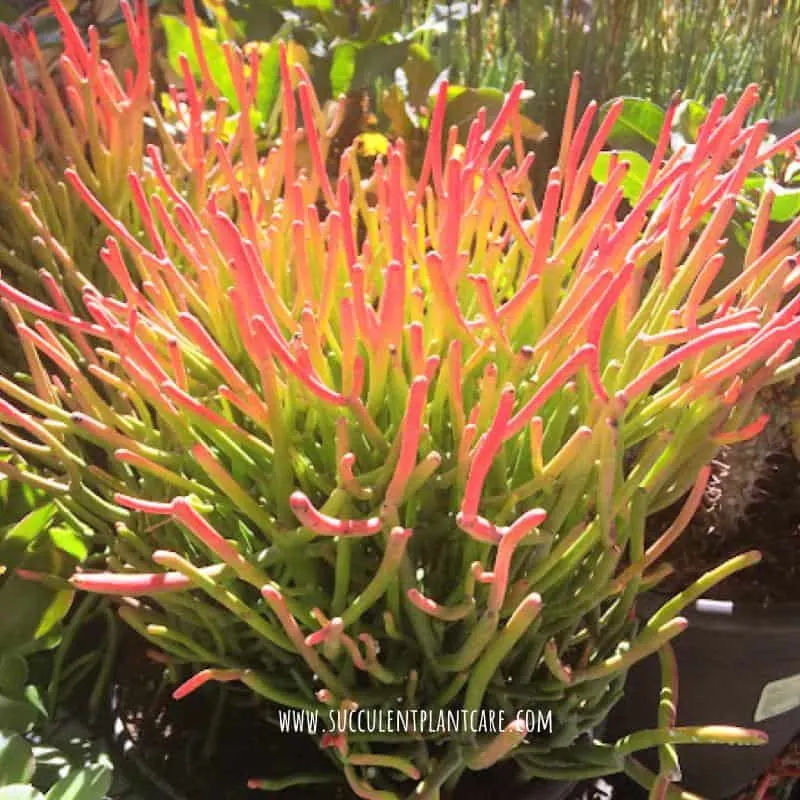
Common Problems with Growing Euphorbia Tirucalli
Brown Leaves
The most common cause of brown leaves on Euphorbia Tirucalli is sunburn. This plant generally does well in full sun, but extreme weather conditions or extreme changes in weather such as a heatwave can cause sunburn or sun damage. This does not really internally hurt the plant as long as the problem is temporary.
Provide some protection or shade during extreme heat waves to prevent brown spots or sunburn. Here are some of my sun shade recommendations.
Shriveled Leaves
The most common reason for shriveled leaves on Euphorbia Tirucalli is underwatering. The leaves will appear shriveled, droopy and dried up. When touched, the leaves will feel flat and deflated.
Shriveled leaves is usually a sign that the plant is running low on its water storage and it is time to water. Give the plant a good drink of water and it should perk up immediately, usually within a day or so. If you notice this happening a lot, you may need to water your plants more often.
Mushy Translucent Leaves
The most common reason for mushy is overwatering. The plant will look unwell and will feel soft and mushy to the touch. These are usually signs you are overwatering your plant. Cut back on watering and allow the plant to dry out and recover from too much water.
Do not water until the plant has had a chance to dry out completely. Consider switching to a fast draining potting mix if the soil is not drying out fast enough and you notice that it stays wet for too long.
If left in wet soil, root rot can set in. Once you notice rot, you can still save the plant by cutting off all the dead parts of the plant. Save anything that looks green and viable to propagate and repot.
Remember, it is easier to ‘fix’ an underwatered plant than an overwatered one so when in doubt, err on the side of caution when watering. For more on this topic, visit my post on “How to Save an Overwatered Succulent Plant”.
Euphorbia Tirucalli Blooms
Euphorbia Tirucalli produces small clusters of yellow flowers on the top branches. These plants will bloom when they are ready or mature enough. There isn’t that much you can do to encourage blooms. Providing the proper care for the plant is enough and the plant will bloom when it is ready.
Euphorbia Tirucalli Toxicity
Euphorbia Tirucalli is considered toxic to humans, dogs, cats or pets. The milky sap it excretes can cause anywhere from mild to severe skin irritations. It is also highly irritating to the eyes and nose areas so care is needed when handling this plant. Ingestion can cause mild to severe irritation to the mouth area and GI tract.
The ASPCA’s (American Society for the Prevention of Cruelty to Animals) website provides valuable information and a comprehensive list of toxic and nontoxic plants for cats, dogs, and other house pets. If you suspect poisoning, contact your local veterinarian immediately or the ASPCA Animal Poison Control Center at 888-426-4435.
Euphorbia Tirucalli ‘Firesticks’ is a great choice to have in your yard or at home due to its easy going nature. This plant does not require a lot of attention for it to grow and thrive. Take the necessary precautions when handling this plant and when keeping it around pets and small children and you will be able to enjoy it for years.
Wondering where to find a Euphorbia Tirucalli plant? Visit my resource page for recommendations on where to purchase these succulents online.
Pin this to save for later or share with others now!
